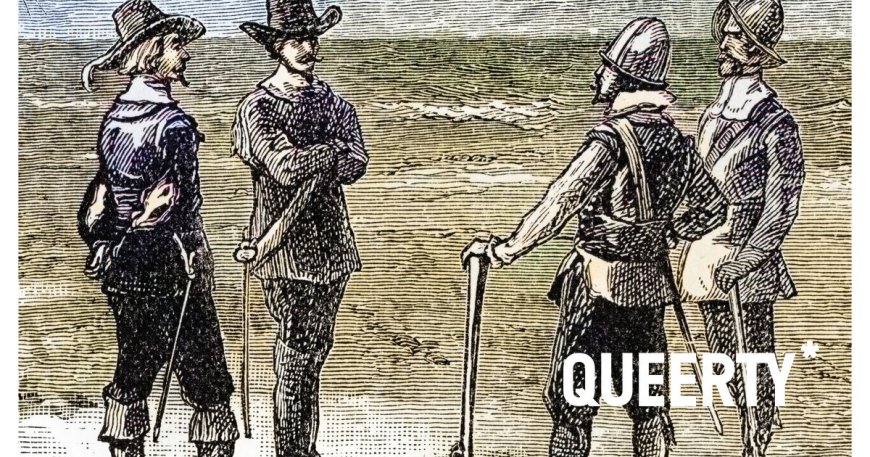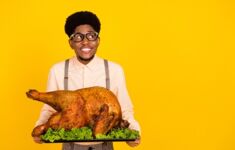Turns out the pilgrims had a ton of gay sex
While it’s unclear from historical records whether or not there was a massive gay gang bang directly before or after the first Thanksgiving circa 1623, there were definitely plenty of twinks scattered around America at that time.


Before Thanksgiving was the capitalist celebration of crowded flights and family-related trauma that it is today, it was an opportunity for America’s power players to wine and dine with peace-loving people who they would later betray.
If that already sounds like your average Sunday drag brunch, then it might not surprise you to learn that there were most definitely queer people at that aforementioned first Thanksgiving.
So, yes, your first grade teacher was wrong. It was not “historically inaccurate” of you to dress up like that pilgrim lady in your school play. OK, OK, sorry, I’ve gone all “final episode of Drag Race” and started talking to my younger self again.
While it’s unclear from historical records whether or not there was a massive gay gang bang directly before or after the first Thanksgiving circa 1623, there were definitely plenty of twinks scattered around America at that time.
For starters, the Indigenous people themselves were already engaging in rigorous gender bending when Europe first started vomiting colonists onto their shores. This included the Wampanoag people, who appeared at that first Thanksgiving. And in the case of the Mamitarees, as the chummy, Brokeback Mountain-esque Lewis and Clark would later describe, some men could even marry other men.
While this pre-Western gender fluidity was a foreign concept to European visitors, it was not unimpactful on settlers. The results of this cultural overlap, propelled by that first Thanksgiving, cropped up almost immediately.
Over in Merrymount, a Massachusetts Pilgrim settlement, citizens were not just freely socializing with the indigenous Algonquin tribe, but freeing slaves for fun and, oh yeah, hosting Pride celebrations.
Well, sort of.
In one description of the settlement’s regular parties, Scarlet Letter scribe Nathaniel Hawthorne cited a “youth in glistening apparel, with a scarf of the rainbow pattern crosswise on his breast. … adorned with pink silk stockings.” During another party, the Merrymount revelers evocatively danced like “Ganymede” and “Zeus,” insinuating that this was a 17th century circuit party.
The best part, at least for America’s early dancing queens, was that no one cared too much. Non-procreative sex, though frowned upon, was usually not considered grounds for imprisonment or even the death penalty. In many cases, it simply resulted in a slap on the wrist, such as was the case for Nicholas Sension, who received a mere fine and public shaming after propositioning countless men between 1642 to 1672 in Connecticut.

Puritans, of course, would later appropriate the concept of sex from cool people and conflate it with religious duties, but for the first half of the 17th century at least, non-procreative sex was anyone’s game. That meant that massive Thanksgiving dinners could very easily have facilitated queer hookups.
There were many reasons for this sexual tolerance, and most of them had to do with the fact that life was already hard enough for America’s earliest settlers. They couldn’t go around executing queer people willy-nilly; they had a population to maintain. It was already miraculous enough that these queens had lived past 30. (In those times, queers didn’t experience “gay death” at 30; they literally just died.)
Still, at the end of the day, it was considered gauche to talk about gay stuff out loud – just like at modern-day Thanksgivings, when queers share dinner tables with their daffy, right-leaning Catholic aunts. It was for this reason that the earliest records of queerness have been relegated to sporadic criminal complaints.
In 1637, for instance, John Allexander and Thomas Roberts were charged with “lude behavior and uncleane carriage one w[ith] another, by often spendinge their seede one vpon another.” Sounds like your average Corbin Fisher video! Additionally, in 1629, a ship was reported as carrying “5 beastly Sodomitical boys [who] confessed their wickedness not to be named.”
Five beastly sodomites? Sounds like the dark room at Rockbar!
One exception to this rule involved the case of “Thomas-ine Hall,” a resident of early colonial Williamsburg, VA who alternately lived their life as a male “Thomas Hall” or female “Thomasine Hall,” depending on their mood. Thomas-ine was never accused of a crime, but was instead ordered to wear both men’s and women’s clothing after being discovered to be “both a man and a woman.” Looking back, it’s possible that Thomas-ine was intersex.
As we know now, all this revelry didn’t last forever. After religious and sexual conservatism swept America in the 17th and 18th centuries, homosexuality was eventually confined to underground gay bars similar to England’s 18th century “molly houses.”
In the meantime, however, queer people could still exchange winks and nods at Thanksgiving before traipsing off to the woods to bone. Plus, nothing could beat that First Thanksgiving in its implicit queerness. Merely by exposing the buttoned-up Pilgrims to the exotic gender fluidity of the Wampanoag natives, that meal subconsciously infected the European hets with an insatiable queer-curiosity that could only be satisfied later with things like “Ganymede-Zeus” dances. Is there anything queerer than that?
Related:
These “gay cousin at Thanksgiving” tweets serve up humor for the holiday
Yes, there is a “gay cousin prophecy” at work at Thanksgiving dinners—and in holiday TV movies—as these tweets attest.

 Mark
Mark 






